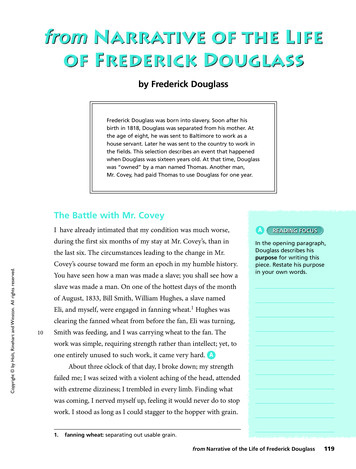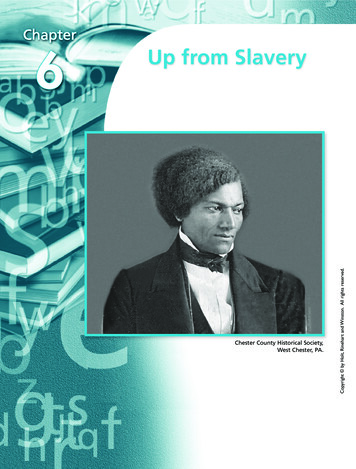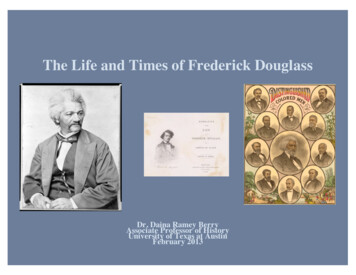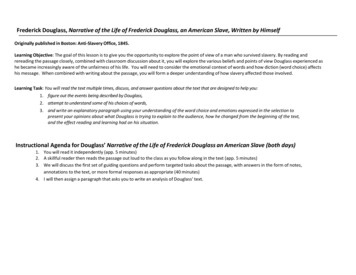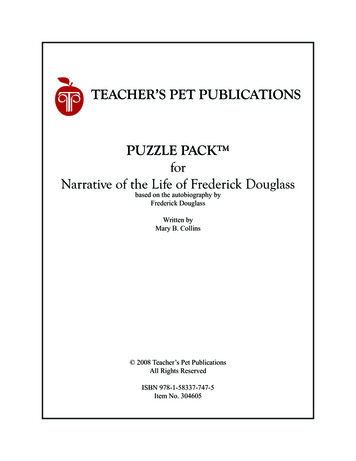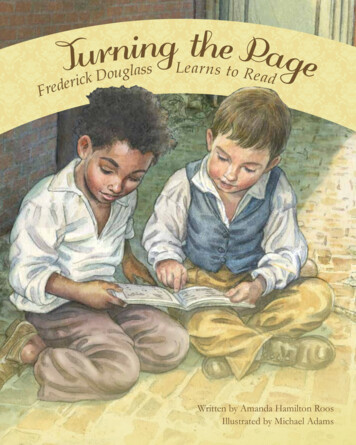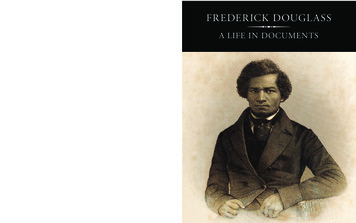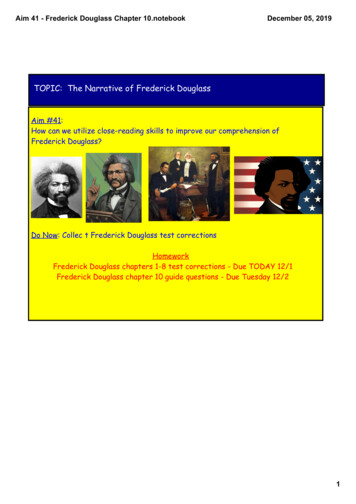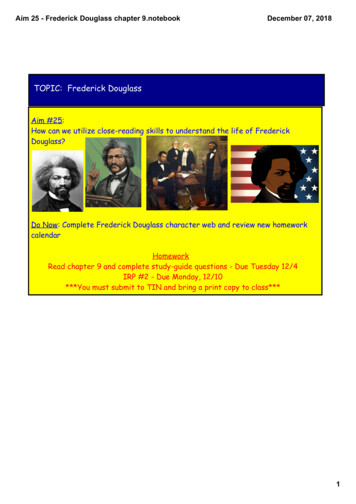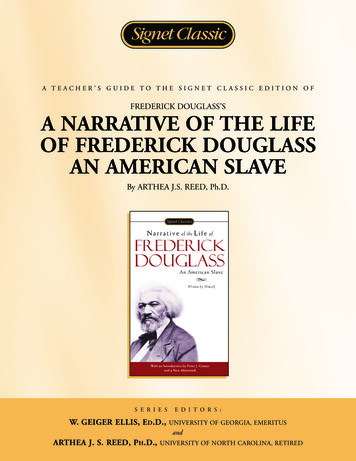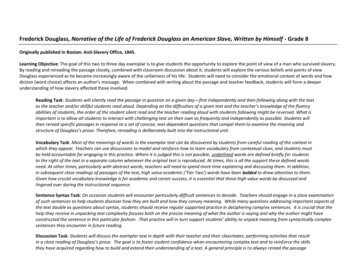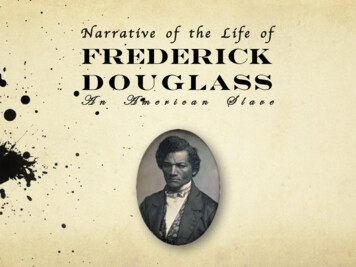
Transcription
Narrative of the Life ofFrederickDouglassA nA m e r i c a nS l a v e
Silly Quiz #9Towards the end of the text, what happened between Mr.Covey and Douglass that Douglass recognizes as a turningpoint in his life?
ObjectivesThe ability to distinguish the purpose of a text.To comprehend the brutality of slave life.Analyze and understand the use of rhetorical devices inorder to persuade the reader of the author’s purpose.
Opening DiscussionWhat aspects or parts of your life are you able tocontrol? What parts are you unable to control?What aspects of a slave’s life do you think he/shecontrolled? What parts was he/she unable to control?
About Frederick DouglassFrederick Augustus Washington Bailey, who later became known asFrederick Douglass, was born a slave in Talbot County, Maryland.He escaped slavery in 1838 and went to New York city and married AnnaMurray, a free African-American woman.He is famously known as an American abolitionist, editor, orator, author,statesman and reformer.As one of the foremost leaders of the abolitionist movement, Douglassfought to end slavery within the United States in the decades prior to theCivil War.During the Civil War, he served as an adviser to President AbrahamLincoln and fought for the adoption of constitutional amendments thatguaranteed voting rights and other civil liberties for African-Americans.
AutobiographyDouglass' most well-known work is his autobiography,Narrative of the Life of Frederick Douglass, an American Slave,which was published in 1845.Critics frequently attacked the book as inauthentic, notbelieving that a black man could possibly have produced soeloquent a piece of literature.The book was an immediate bestseller, selling over 11,000copies and received overwhelmingly positive critical reviews.
Text AnalysisStyleStyle is a writer’s distinctive way of expressing ideas – notwhat is said, but how it is said. Douglass uses a formal,elegant style that demonstrates his masterful command ofthe language.Elements that characterize style include:Tone, conveyed by choice of words and detailsSentence patterns and structuresUse of figurative languageUse of dialogueDouglass combines crisp, factual narration with bursts ofpoetic language.
Text AnalysisStyleReread lines 31 - 43: What is the effect of Douglass’schoice to use little imagery of figurative language in hisnarration?Reread lines 78 – 88: Identify examples of repetitionand parallelism. What TONE is created by this use oflanguage? What kind of perspective on slavery does ithelp the writer to achieve?
Reading SkillAuthor’s PurposeAn author creates a work to achieve a specific purpose,or goal. In general, an author writes to inform, toexpress thoughts or feelings, to persuade, or toentertain. However, a complex work will often havemore than one purpose.Douglass wrote his autobiography mainly to persuadereaders that slavery should be abolished. To achievethis purpose, he described the physical realities thatslaves endured and his responses to his life as a slave.
Reading SkillAuthor’s PurposeReread lines 31 – 43. What details does Douglass useto inform his readers about the working conditions ofslaves?Reread lines 113 – 144. How does this paragraphfurther the author’s purpose? Analyze Douglass’s tonein this paragraph. Why would he not list his emotionalresponse to the event?
Reasons for Writing anAutobiographyTo present the reality of slavery.To generate enthusiasms for the abolitionist struggle.In his own words,Sincerely and earnestly hoping that this little book may dosomething toward throwing light on the American slave system, andhastening the glad day of deliverance to the millions of my brethrenin bonds--faithfully relying upon the power of truth, love, and justice,for success in my humble efforts—and solemnly pledging my selfanew to the sacred cause.
In His Times Slaves did not know when they were born and couldn’t determine howold they were.Children born into slavery were denied the privilege of knowing theirage and their parentage. A few lucky ones had the liberty to see theirmother 4 or 5 times in their lifetime.I have no recollection of ever seeing my mother. She made herjourneys to see me in the night, traveling the whole distance of 12miles on foot. Her death soon ended what little we could have whileshe lived, and with it her hardships and suffering .
Organization of the BookThe book is divided into eleven chapters describing his life, from birthinto slavery to escape into freedom.In the first few chapters, he gives an account of his childhood andnarrates few incidents revealing the horrible character of slavery and thedevilish atrocities inflicted upon them.In the next few chapters, Douglass describes his struggle towardsfreedom at Baltimore. He speaks about his everlasting and unabateddesire to learn to read, realizing that education is a pathway fromslavery to freedom.Towards the end, he describes his efforts in planning to escape to thenorth, to become his own master’.
The Genre – A Slave NarrativeThe slave narrative is a literary form which grew out of the experience ofenslaved Africans in the New World. Some six thousand former slavesfrom North America and the Caribbean gave an account of their livesduring the 18th and 19th centuriesThe Genre soon emerged as a mainstay of African American literature.North American and Caribbean slave narratives can be broadlycategorized into three distinct forms: Tales of religious redemption, Talesto inspire the abolitionist struggle, and Tales of progress.The tales written to inspire the abolitionist struggle such as FrederickDouglass's autobiography, are the most famous because, they tend tohave a strong autobiographical motif.
A Review and Analysis of theBookOften, the reader is left to figure out the psychology behind the awfulincidents described while Douglass simply explains his feelings andreactions.Douglass often interrupts his own story to tell tales of other slaves. Hedoes this to emphasize his points and show the extent of the cruelty andwrong of slavery even if he wasn’t directly involved in the event hedescribes. These side stories work to tell the whole tale of slavery byshowing the extent to which the cruelty was manifest.The slave auctioneer's bell and the church-going bell chime in witheach other, and the bitter cries of the heart-broken slave are drownedin the religious shouts of his pious master .A turning point in the narrative comes after an incident in whichDouglass revolted back against his master, for the first time in his life.He describes this incident as the turning point in his life, for it rekindledthe flame of hope for freedom in his heart.
DiscussionHow did Master Thomas respond when Douglassasked for protection from Covey? What does this showyou?How was the battle with Covey a turning point inDouglass’s life as a slave?Based on his final battle with Mr. Covey, how do youthink Douglass feels about the following topics:Individual rightsSelf-relianceResistance to tyranny
Douglass' most well-known work is his autobiography, Narrative of the Life of Frederick Douglass, an American Slave, which was published in 1845. Critics frequently attacked the book as inauthentic, not believing that a black man could possibly have produced so eloquent a piece of literature. The book was an immediate bestseller, selling over .
